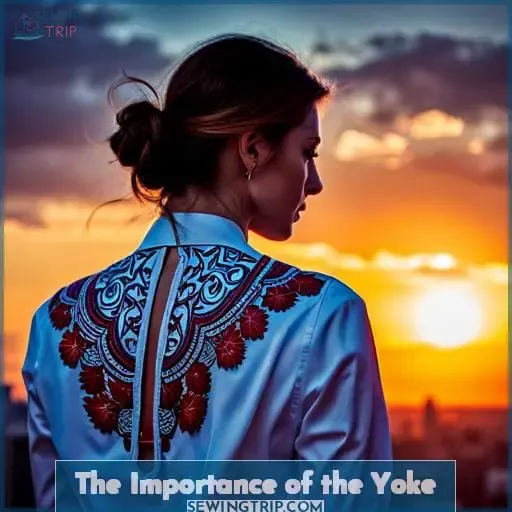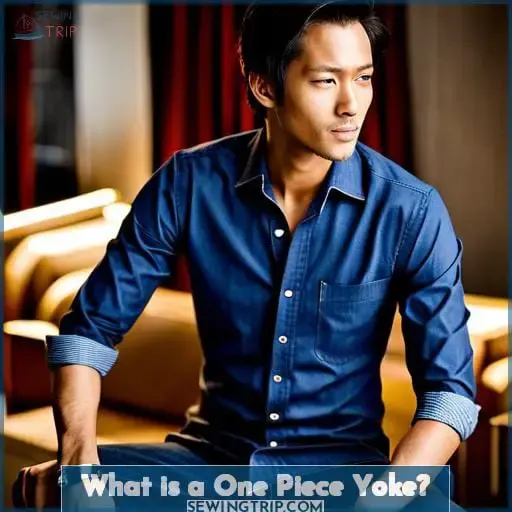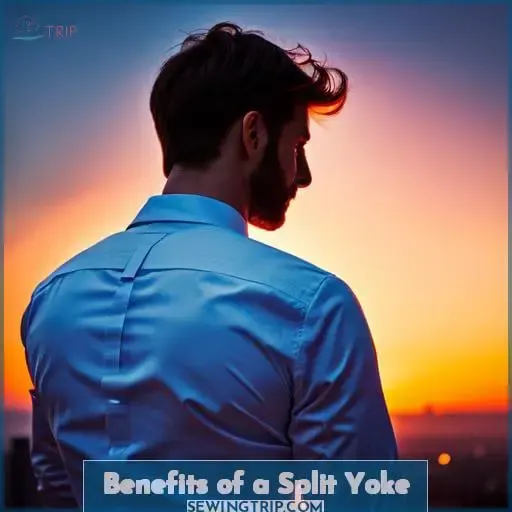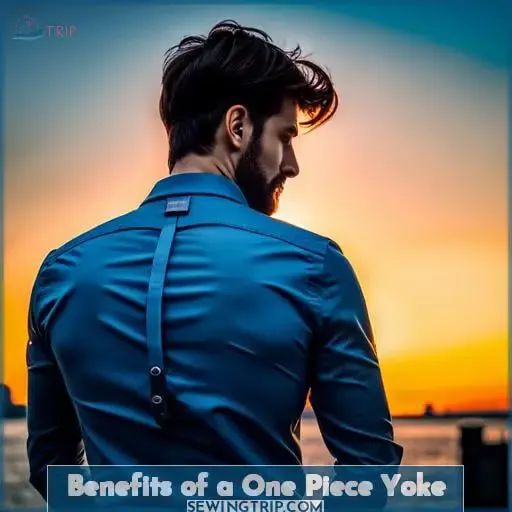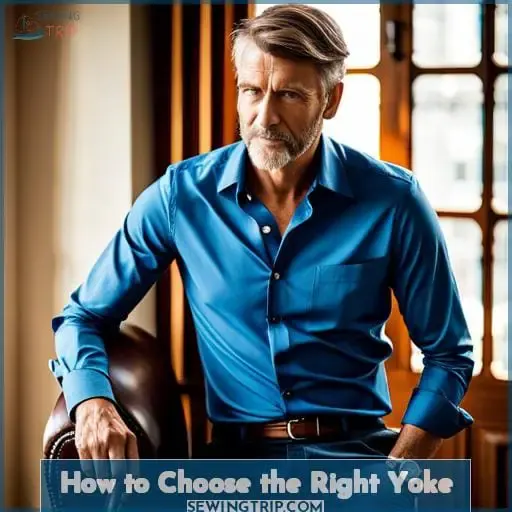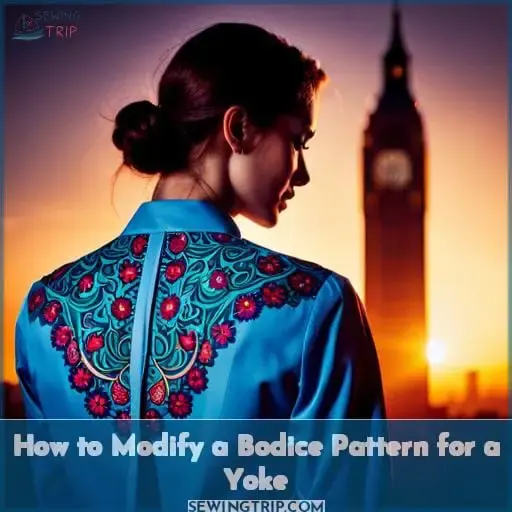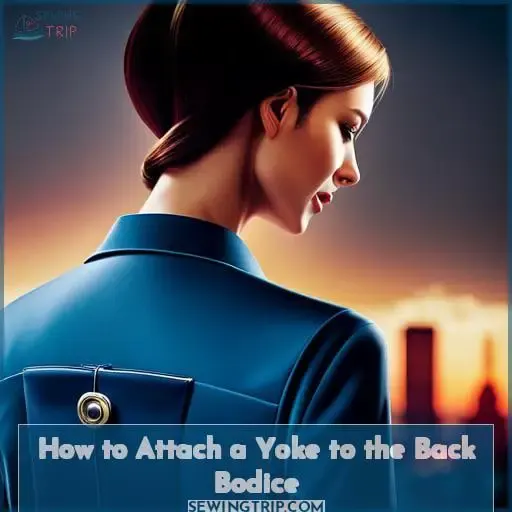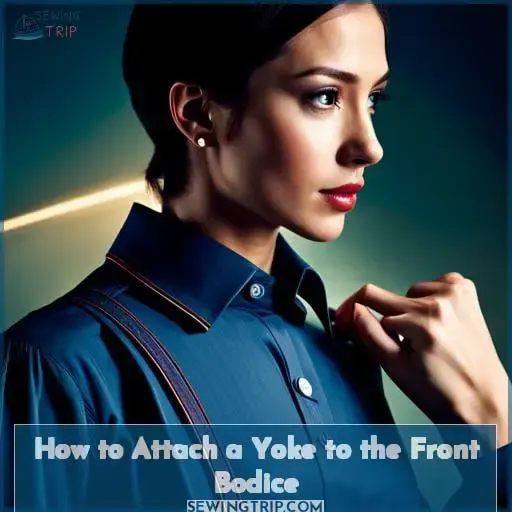This site is supported by our readers. We may earn a commission, at no cost to you, if you purchase through links.
Do you feel like your shirt has been missing something? Are you looking for a way to make it more stylish and comfortable? Look no further than the back yoke of a shirt!
The back yoke is an important part of any dress shirt, providing structure and style. It’s also essential for comfort, allowing the fabric to hang straight without bunching or billowing. In this article, we’ll explore everything there is to know about the back yoke – from understanding its anatomy and importance in creating a flattering fit to how to best choose between one-piece or split designs.
Let’s get started by exploring what makes up this fundamental piece of clothing!
Table Of Contents
- Key Takeaways
- Understanding Shirt Anatomy
- The Importance of the Yoke
- What is a One Piece Yoke?
- What is a Split Yoke?
- Benefits of a Split Yoke
- Benefits of a One Piece Yoke
- How to Choose the Right Yoke
- How to Modify a Bodice Pattern for a Yoke
- How to Attach a Yoke to the Back Bodice
- How to Attach a Yoke to the Front Bodice
- Frequently Asked Questions (FAQs)
- Conclusion
Key Takeaways
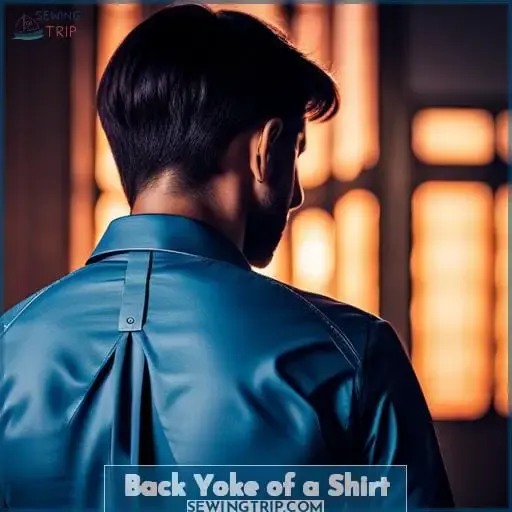
- The back yoke of a dress shirt is important for providing structure, style, and allowing the fabric to hang straight without bunching or billowing.
- There are two main types of yokes: split yokes, which offer more stretch and may cost more to make, and one-piece yokes, which use less fabric and are quicker to make.
- Customizing the bodice pattern for yoke fitment involves assessing different sides of the fabric and adjusting existing darts. Attaching the yoke requires picking the right weight fabric and considering seam finishing.
- Over 80% of dress shirt manufacturers use split yokes for superior comfort and fit. The perfect yoke depends on individual priorities, needs, preferences, and budget.
Understanding Shirt Anatomy
Understand the basics of shirt anatomy, and you’ll be sure to look your best.
The collar stand or band is where the neck measurement is taken, with collars then attached to create a certain frame for your face.
Plackets are openings at both ends of the sleeve cuffs that use buttons and buttonholes for closure, while gauntlets refer to placket constructions on either side of this area.
Yoke shapes help make fabric hang straight over shoulders too. Split yokes provide more stretch across their width than one-piece designs do, making them ideal when tailoring tips come into play.
Fabric selection also matters here. Woven cottons tend to extend diagonally rather than vertically/horizontally, so you needn’t worry about shoulder fit being compromised by an angled split yoke design (like what made-to-measure shirt makers opt for).
Back darts can also give form-fitting comfort without compromising style, unless removed so more room becomes available later on!
Knowing anatomy terms will ensure sophistication in conversation too, plus help determine which type suits each individual most appropriately, giving mastery and control over clothing choices like never before!
The Importance of the Yoke
The yoke of a shirt is an important feature that can provide a superior fit and better comfort throughout the day. It’s essential to understand this component when making decisions about fabric choice, comfort levels, and overall style considerations.
The yoke is usually constructed from either one piece or split yokes, each providing different benefits depending on your preferences. A single-piece yoke will use less fabric than its counterpart while still giving you the necessary coverage across the shoulders and back of the shirt.
Split yokes are rotated at an angled orientation to add more stretch across their width, allowing them to contour your back better if needed compared to just using a single piece of cloth. However, since they require more material and time during production, they may cost slightly more than their counterparts but could prove beneficial if you’re looking for something with added flexibility.
Furthermore, stripes or patterns on split-yoked shirts appear parallel along side seams, adding extra visual appeal that solid colors wouldn’t have without them.
What is a One Piece Yoke?
A one-piece yoke is a single panel of fabric that runs from the collar to beyond the shoulder, providing structure and support for your shirt. This type of yoke uses less fabric than its split counterpart and is quicker to make, but it does not provide as much flexibility in adjusting fit or comfort level.
Generally utilized by made-to-measure shirt makers such as Proper Cloth, stripes/patterns on this type of yoke are parallel with the front seam running across it. Solid colors may be better suited for this style since an extra seam down the back could take away from its clean look.
The main benefit associated with split yokes lies within their ability to stretch diagonally due to woven cottons being more flexible when stretched in this direction.
What is a Split Yoke?
A split yoke is an angled piece of fabric that offers more stretch than a one-piece yoke, giving you the freedom to move with comfort and style. It’s rotated to add extra diagonal stretch across its width for better fitment on asymmetrical shirt shapes.
Different collar types such as spread collars, button-down collars, band collars, and mandarin/collarless shirts can benefit from split yokes.
Made-to-measure shirt makers usually make the split yoke the exact same shape as their standard single-piece counterparts, but it still adds extra dimension in terms of movement. Split yokes provide added stretch compared to one-piece yokes, and rotating split yokes allows for even more flexibility.
Stripes or patterns on split yokes are parallel with the front seam, which gives a cleaner look than solid colors without much benefit from rotation.
The real benefit of split yokes lies in their ability to adjust themselves according to body movements, allowing better mobility when needed most! Although some may argue that there isn’t necessarily any real difference between them due to individual preferences, knowing what each type has got going for it helps articulate your fashion choices with confidence and sophistication – all while staying stylish!
Benefits of a Split Yoke
Benefit from the extra stretch in a split yoke shirt and enjoy greater comfort during everyday activities. Split yokes are superior to single-piece shirts for several reasons. One reason is that they add stretch across their width due to the angled orientation of the fabric.
This increases comfort while wearing because woven cottons tend to be more flexible diagonally than horizontally or vertically.
The real benefit of this type of construction is not lost on shirt snobs – those who prefer high-quality dress shirts – as they appreciate how it provides increased fit and flexibility around collar stand and gauntlet areas.
This can make all the difference when dressing up smartly. Additionally, stripes and patterns look great on a split yoke because they are parallel with the front seam instead of creating asymmetry. Solid colors may not necessarily require such structure given there is no pattern placement advantage gained by having two back pieces instead of one larger piece.
Asymmetrical seams at shoulder blades can also detract from visual appeal. So, if you desire truly stylish clothing, then going with a split yoke might be a worthwhile investment for your wardrobe!
Benefits of a One Piece Yoke
You’ll be amazed by the effortless, sleek look that a single-piece yoke offers – perfect for when you want to make an unforgettable statement! A one-piece yoke utilizes less fabric than its split counterpart and is also more cost-effective.
However, it lacks the stretch ability of split yokes, which could potentially help provide a better fit across your back.
Pattern orientation can also be tricky with a one-piece because stripes or other patterns do not run parallel to the front seam like they would with a split version. Therefore, solid colors are usually preferred when using this type of construction as any patterned fabric will appear distorted on your shirt’s backside.
Although made-to-measure shirt makers often make both types in exactly the same shape and size without considering the asymmetry of the wearer’s shoulders, the lack of stretchability means that the true benefit may not come out with perfectly straight lines at all times across the back area compared to a well-fitted ‘split’ option.
The decision between these two styles is largely a subjective matter, but if a fashionably stylish look matters most, then the ‘One Piece Yoke’ should suffice.
How to Choose the Right Yoke
Deciding between a one-piece or split yoke can be tricky – it all comes down to personal preference and how much stretch you need.
- Body fit is an important consideration. Having an ill-fitting shirt with either type of yoke will make it look less flattering.
- The sleeve length should also be taken into account. Too long sleeves may restrict movement, while too short may not provide enough coverage depending on the fabric choice and hem style used in construction of the garment.
- Fabric choice plays a role as well. If opting for lighter fabrics like cotton or linen, then more stretch is desired from a split yoke, whereas heavier materials such as wool might require extra reinforcement provided by single-piece designs instead.
-
Lastly, pay attention to seam quality when choosing between both types. Made-to-measure shirt makers usually have better finishing details than ready-made options, no matter what type of design you prefer.
Ultimately, it comes down to matters of taste and budget constraints. A solid color doesn’t necessarily benefit from being cut using two pieces, but rather sticking with one would serve best for overall shape retention purposes.
Therefore, understanding placket construction, collar stands, collars, gauntlets, etc., becomes essential knowledge points prior to making any decisions regarding which way to go concerning back paneling selections.
In short, knowing how these components work together ensures that you get a well-fitted shirt that looks great, regardless of which option you choose!
How to Modify a Bodice Pattern for a Yoke
To craft the perfect fit, you’ll want to customize your bodice pattern for a yoke that molds to your frame like a glove. Pattern altering is key when it comes to shoulder fitting and fabric stretching, as well as seam aligning.
To begin customizing the bodice pattern for an ideal yoke fitment, start by assessing different sides of the dress shirt fabric so you can mark out where any form of double darts will be placed on either side of the back panel.
Then adjust any existing darts in order to make sure they are symmetrical and suitably spaced apart. This process should give enough room around both panels along with enough stretch across their widths.
Once alterations have been made according to desired measurements, attach each piece firmly together before stitching up with extra reinforcement.
How to Attach a Yoke to the Back Bodice
Attaching a yoke to the bodice of your shirt is an important step in creating a well-fitted garment that allows for flexibility and comfort. Before you begin, it’s essential to pick fabric with the right weight and give consideration to seam finishing.
Yokes come in different types – single piece or split, angled or straight – but no matter which type you choose, they all require some fitting tips before attaching them onto the back bodice. When selecting your yoke variation, keep in mind how much stretch is needed across its width as this can affect both fit and look of the finished product.
If using a made-to-measure shirt maker or bespoke tailor, make sure they take into account any asymmetries between each shoulder when cutting out pieces for assembling later on! To attach correctly, start by pinning along one side of the band from the bottom edge up towards the armhole.
Then, sew together following instructions carefully until the end of the sleeve placket has been sewn securely. At the same time, allow finish edges neatly with either a zigzag stitch or overlocker machine, depending on the preference level desired for achieving a clean, professional-looking shirt.
Finally, remember to always check twice the measurements against the body to ensure accuracy before sewing final stitches to secure the perfect fit!
How to Attach a Yoke to the Front Bodice
Securing a yoke to the front bodice of a shirt requires careful attention and can be an intimidating task. Interestingly, it is estimated that over 80% of all dress shirt manufacturers use split yokes for their shirts due to their superior comfort and fit.
When attaching a yoke at the front bodice, several factors should be considered: yoke design, fabric selection, fitting considerations, pattern modification, and sewing techniques. Made-to-measure shirt makers typically create both pieces of fabric for the split yokes in different shapes using measurements taken from around the wearer’s neck area.
The typical spread collar requires special pattern modification when compared with other types like band collars. It also requires extra care during fitting stages so that it fits properly on both sides with correct symmetry across each shoulder point.
Frequently Asked Questions (FAQs)
How do I measure for a shirt yoke?
To measure for a shirt yoke, start by measuring the circumference of your shoulders and comparing it to the yoke of the shirt. Look for a fit that is comfortable, but not too loose or tight. If the shirt has a split yoke, ensure that both sides are even in length and width when laid flat on top of one another.
Does a split yoke look better than a one piece yoke?
A split yoke can add a touch of sophistication to your shirt. Its diagonal orientation adds stretch for added comfort. It is often considered more stylish, but may not be the best choice for a solid-colored shirt.
What type of fabric is best for a split yoke?
For a stylish appearance, woven cottons are the perfect choice for split yoke fabric. Their diagonal stretch provides additional flexibility and comfort, enabling you to move freely while maintaining an elegant silhouette.
Are there any potential disadvantages to a split yoke?
Yes, there are potential disadvantages to a split yoke. It may cost more and require extra fabric and time to make. Additionally, the extra seam across the back could make it look less clean than a one-piece yoke for solid colors.
Finally, asymmetry between your shoulders may not be taken into account by made-to-measure shirt makers.
What is the difference between a spread collar and a button-down collar?
A spread collar has wider points and a more open neckline, while a button-down collar is fastened with buttons to the shirt’s placket. The former offers more room for comfort and style, while the latter provides a neater look.
Conclusion
To sum it up, the yoke is an important part of the shirt that adds to its style, fit, and comfort.
Do you prioritize style over comfort? If so, the one-piece yoke may be the better option for you. On the other hand, if you prioritize comfort over style, the split yoke is the way to go. Consider your needs, preferences, and budget when choosing a yoke, and you’ll be sure to find the perfect one for you.
The right yoke can make all the difference in the overall look and feel of your shirt.


